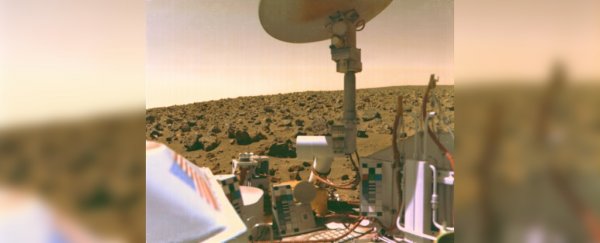When NASA confirmed the Curiosity rover had found traces of complex organic compounds on Mars recently, it wasn't just a promising sign that the building blocks of life might exist on the Red Planet.
Curiosity's ongoing discoveries have also turned up a crucial piece of chemical evidence, shedding light on a strange scientific mystery that has divided astronomers for decades – with controversial new findings now suggesting NASA's own scientists may have unwittingly burned evidence of Martian organics back in the 1970s.
In 1976, NASA's Viking program sent two landers to the surface of the Red Planet, to conduct the first investigations looking for organic compounds in the Martian dirt.
To everybody's complete surprise, the search turned up nothing.
"It was just completely unexpected and inconsistent with what we knew," NASA astrobiologist Chris McKay explained to New Scientist.
The reason Viking's failure to detect organic compounds was such a shock is that scientists had hypothesised meteorites and comets containing carbon and impacting upon the Martian surface should have deposited traces of organic material on the planet – so Viking's blank readings didn't add up.
Since then, other scientists have suggested that meteorite impacts might actually be capable of obliterating organic molecules – not just depositing them – but according to McKay's new research, meteorites aren't the only thing that might destroy potential signs of life on Mars.
To understand why, we need to consider some of the other Martian discoveries.
In 2008, NASA's Phoenix lander found evidence of a toxic, salty compound on Mars called perchlorate, which contains chlorine, and is actually used as a propellant for rockets and fireworks due to its explosive properties.
That discovery might be interesting, but it wouldn't necessarily be anything else, if it weren't for one historical fact. Back in the 1970s, the Viking landers' equipment had to heat up its Martian samples for its primary instrument – the gas chromatograph‐mass spectrometer – to do its job analysing them.
The thinking goes that heating those samples up could have ignited the perchlorate, instantly destroying any organic compounds that may have been present, leaving nothing organic for the spectrometer to detect.
For a long time, scientists have been aware there might have been significant shortcomings like this with Vikings' lab workflow – but it was Curiosity's more recent discoveries that provided something tangible to round out the theory.
The missing piece of the puzzle was a molecule called chlorobenzene. In 2014, NASA announced Curiosity had discovered this compound on Mars in 2013, and it just so happens that chlorobenzene is the chemical product of burning carbon with perchlorate.
That's not necessarily proof of anything, but when McKay's team went back and reanalysed the original Viking data from the 1970s, it showed chlorobenzene was detected way back then on Mars.
Alas, nobody realised the smoking gun… which may have only existed because NASA's own equipment could have incinerated the very evidence of organic molecules they'd spent some US$5 billion to find.
Of course, that's just one possible interpretation of the data. We don't know if it's what actually happened, but it goes some way to explaining why those surprising 1970s results turned out the way they did.
And it also serves as a reminder that even the most accomplished space scientists in the world might not always get everything right. After all, they're only human.
The findings are reported in the Journal of Geophysical Research: Planets.
